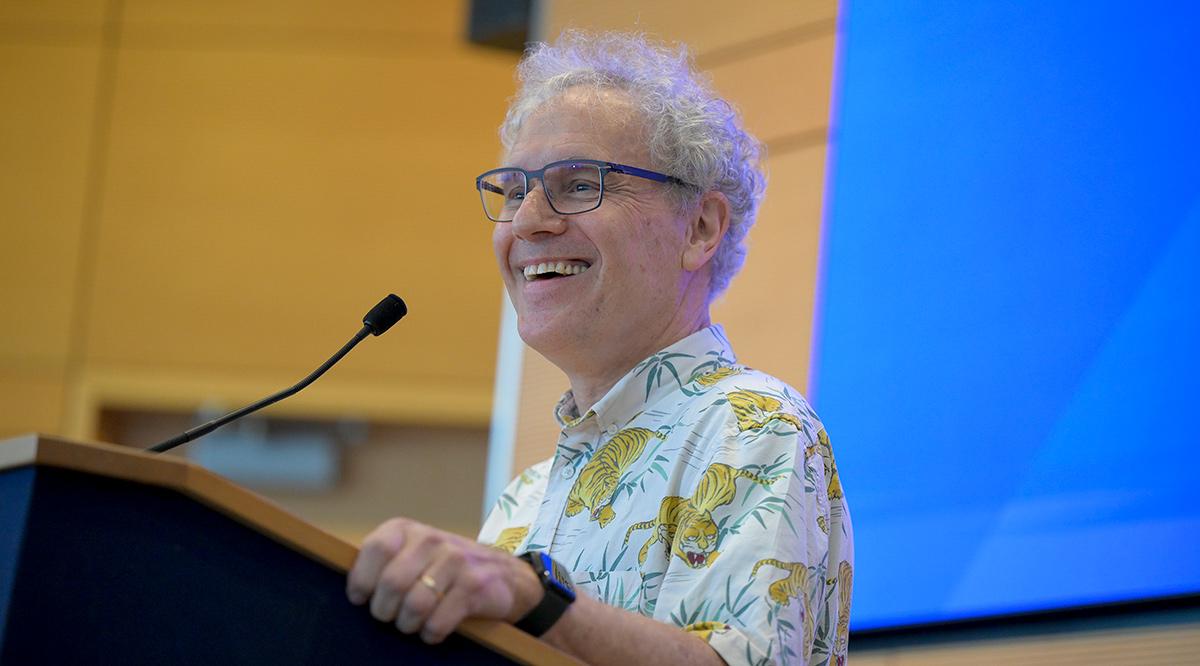When he started out as a research scientist decades ago, Victor Ambros, PhD, just wanted to build a stable career. For that he turned to experimenting with a roundworm: Caenorhabditis elegans, which measures one millimeter, lives for three weeks, and is literally transparent. Several of its traits, including rapid reproduction, make the C. elegans particularly suitable for lab experiments.
“My goal initially was simply to establish myself as an independent investigator so that I could get a job,” says Ambros, whose jobs now include professor of natural sciences at the UMass Chan Medical School and principal investigator (PI) of the school’s Ambros Lab.
Ambros did not envision making a breakthrough discovery about a genetic mechanism that regulates human development and disease — one that would win him and colleague Gary Ruvkun, PhD, the 2024 Nobel Prize in Physiology or Medicine.
The Nobel Assembly at Karolinska Institute cited their “groundbreaking discovery,” through experiments on C. elegans, of microRNA: a class of small RNA molecules that help to regulate gene development in animals. As explained by the Nobel Assembly, microRNA guides genes in the healthy development of cells for such tissue as muscle and intestines — but sometimes “gene regulation goes awry,” which “can lead to serious diseases such as cancer, diabetes, or autoimmunity.” (Read details about the science.)
While the science behind the discovery of microRNA is remarkable, also remarkable is what the discovery illustrates about the importance of basic science research (such as that funded by the National Institutes of Health [NIH]), as well as the multiplying power of scientists at different institutions sharing information about their parallel investigations.
The basic story: Ambros and Ruvkun worked together as postdocs in the Horvitz Lab at MIT, then went on to study C. elegans at separate institutions. (Ruvkun is a professor of genetics at Harvard Medical School and a researcher at Massachusetts General Hospital.) They stayed in touch over the years, often discussing findings about worm genes they were studying (the lin-4 gene for Ambros; the lin-14 gene for Ruvkun). Looking at each other’s study results at one point, they realized that lin-4 essentially turns off lin-14 by blocking protein production. But how?
The mechanism, they discovered, was a previously unknown type of RNA: microRNA, which acts as a sort of on-off switch for the activities of genes. The Nobel Assembly noted that “abnormal regulation by microRNA can contribute to cancer, and mutations in genes coding for microRNAs have been found in humans, causing conditions such as congenital hearing loss, eye and skeletal disorders.”
The discovery has led to numerous studies about the impact of microRNA on human development and disease. Although microRNA therapeutics have been tested in clinical trials, no microRNA therapies have been approved for treatment.
Ambros recently talked with AAMCNews about the microRNA discovery process. This interview has been edited for clarity and brevity.
Why did you set out to study this roundworm?
My goal was to make some useful studies that could be publishable that would establish me as a credible scientist. C. elegans was considered a good model for other animals because it had all the cell types that most of us have — nerves, muscles, brain, intestine. I felt that maybe this would be the model organism where I could make some contributions to developmental biology, to do research into compelling questions about animal development.
That was my goal: to get a job and keep a job.
How did you and Dr. Ruvkun come to communicate so often when you went to different institutions after working together on C. elegans at MIT? Was there ever a feeling of competition?
The expectation was that we would communicate at key times [in our research]. We were influenced by the spirit of this growing C. elegans [research] field, influenced primarily by leaders who instilled in the younger people a sense of responsibility to a community effort. The idea would be that we would do our parts, but we would share and communicate with others. We were just one of dozens of labs around the world that were cloning different genes, communicating all the time.
There were times that I would say [to myself], “Gary is really smart. I hope he doesn’t skip ahead of me.” That keeps you in communication. There came a time when each lab had succeeded in getting enough DNA sequence of our respective genes where we said, “Let’s share the sequence” [of those genes].
Can you describe when you and Dr. Ruvkun realized how your findings complemented each other? You each published papers about your C. elegans findings in the same issue of Cell in 1993, and you both saw that lin-4 somehow regulated lin-14.
We called each other and there was a lot of excitement. We knew that was a mechanism — this is how it works. I don’t know that I thought, “This is going to be huge.” I thought, “This is publishable. I can show this to the NIH and maybe they’ll keep funding me.” Because we accomplished something cool.
When AAMCNews interviewed Dr. Drew Weissman about his mRNA research [for which he co-won the Nobel Prize in Physiology or Medicine in 2023], he recalled that when he and his partner published one of their major papers, he told her that the phones were going to ring off the hook because of the results. The phones did not ring. The papers that you and Dr. Ruvkun published in Cell met with silence as well. Scientists didn’t think your findings applied to humans.
What should young research scientists keep in mind about the immediate response to their research versus the importance of that research?
Drew was justified in thinking his phone should have rung off the hook, because he could envision the application [of his research to humans]. The applications were apparent. I had a conversation with him in Stockholm [at the Nobel awards ceremony last December], where I had to say to him, “I missed your paper too.” I hadn’t thought about the utility of supplying mRNA to a cell. Lack of imagination.
But there were plenty of people who should have known better and should have been calling him.
Some people complained about your wife [Rosalind “Candy” Lee] not sharing the award, even though she was the first author on the Cell paper that the Nobel Assembly cited. From what I’ve read, that didn’t bother the two of you.
On these projects [under both me and Ruvkun], there were at least five people who are the major critical contributors. Without them, it would never have happened. I did one or two experiments.
Once you start pulling in the folks who did most of the [lab] work, you have four or five trainees, techs, or scientists. You can’t single out one or two. The deal is that the PIs get the prize, because they [the Nobel awards] have a maximum of three [recipients].
For Gary and me, we’re obliged to make sure that we emphasize this is how science works. There are teams of people and each person is indispensable.
It’s important for the public to understand that the Nobel Prize presents an opportunity to illuminate, for the world, how science is done. Me and Gary, we’re not here to say that science is done by geniuses. It’s done by teams, and it happens because the public funding has supported people at universities doing science like this.
What are your thoughts about how current shutdowns and cutbacks in NIH grant funding might disrupt critical research? And how might it affect the mindset of young scientists or of students who are thinking about going into research?
This is an urgent risk to the research enterprise in the United States, which has become a world leader. If you play out what’s happening now, it [research] will be crippled for decades. If you cut funding to grants at a university, people lose jobs immediately. Those people are highly trained, and they go off into something else, maybe pharma. Even if the funding comes back in a year or so, they’re gone.
The indispensable component here is the partnership between the public — taxpayers — and the universities. The NIH has had the strong commitment to supporting basic science with the anticipation that it might pay off in unexpected ways. You cannot predict what the outcome will be for [any particular] study. But we know this study is valuable because it’s going to uncover novel principles of biology.
As far as the basic science track record of the NIH is concerned, I’m really a poster boy for that. C. elegans was a minor model organism [for scientists to study]. I’ve been supported by NIH [grants] for 40 years. The NIH’s bet on basic science is a damn good one.
How has winning the Nobel Prize affected you?
I now have opportunities that I wouldn’t have otherwise. For example, you being interested in chatting with me. It gives me a chance to tell my story: son of a Polish immigrant who never finished middle school because the war [World War II] interrupted his education. He started farming in Vermont. I grew up there with eight siblings. I went to school, I work in labs, and [have been] supported by the NIH for 40 years.
Sharing our stories is a blessing. My voice has some potential to inject a little bit of positivity. The world looks to the United States as an example [of how to conduct scientific research]. The public — through paying taxes and through robust institutions like the NIH, NSF [National Science Foundation] — partners with universities, which are populated by people who are motivated by passion and curiosity. That’s the chemistry.
We’ve discovered a way to do this, and everybody emulates it around the world. Why stop doing what we have always done well?
The public should be proud of what they’ve accomplished together with the universities. That’s missing in our public discussions. Let’s be proud and keep it going.

